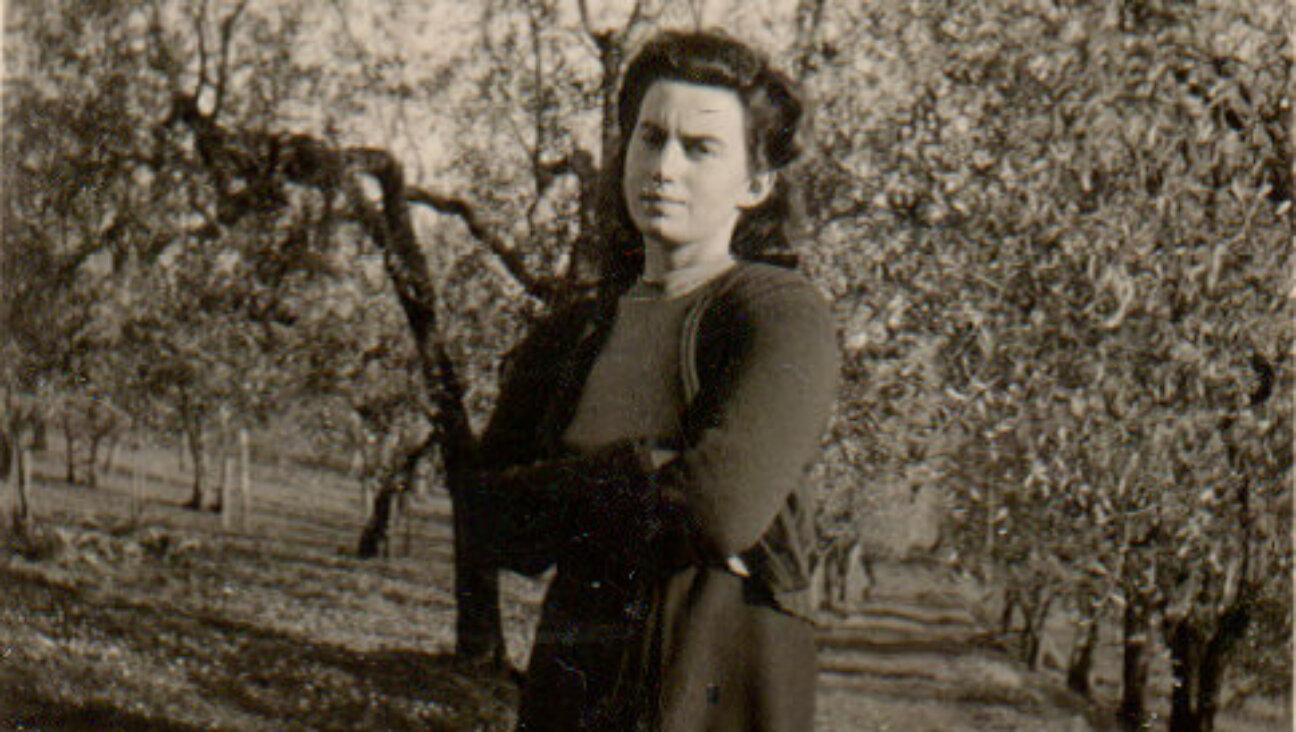For Saul Bass on his 100th birthday

Saul Bass’ poster for “The Man with the Golden Arm.” Image by Wikimedia Commons
To say that Saul Bass designed the 1950s and ‘60s might be an understatement. In truth, you could say that he designed about three or four decades more.
The Bronx-born artist, known for his cubist silhouettes and part-for-the-whole approach, would have turned 100 on May 8. The highlights of his career in film lasted almost half a century, beginning with “Carmen Jones” and ending with an unused design for “Schindler’s List.”
Prolific in poster and credits sequences, Bass, with his embrace of negative space and jaunty sans serif fonts, was wedded to a certain kind of popular-yet-prestige director. Alfred Hitchcock, Otto Preminger and Martin Scorsese knew his gift for meaningful minimalism. He was an editor’s best friend, allowing those in the cutting room to perfectly time his pops of color or reveals of names to the music of Bernard Hermann or Leonard (and Elmer) Bernstein. He was among the first to consider the opening credits’ potential as something more than a SAG and PGA mandate, easily skipped and seldom remembered.
“I had felt for some time that audience involvement with a film should begin with its first frame,” Bass said in a 1977 interview with Herbert Yager, conducted as part of Stan Hart’s film “Bass on Titles.” When Bass was given the chance to make his static ad designs for “Carmen Jones” and “The Man With the Golden Arm” come to life on screen, he seized the moment. “There seemed to be a real opportunity to use titles in a new way — to actually create a climate for the story that was about to unfold.”
“Man With the Golden Arm,” with its Guernica-esque limb formed from a collision of cut paper, made Bass’ reputation; the rest — for all but him — was imitation.
The proof of Bass’ unaccountable success in both Hollywood and on Madison Avenue is how quickly his signatures assumed the status of cliché. Though original, he was not inimitable, and many tried to absorb his aesthetic. This poster, and this one, and this one, too, were not done by Bass. But, save for some telltale features — namely, the presence of them beyond mere shapes — they were clearly informed by the atmosphere he dreamed up at the drafting table and dispatched to cinemas around the world.

Saul Bass’ poster for “The Man with the Golden Arm.” Image by Wikimedia Commons
Bass’ aura wasn’t just in the kinetic, sliding geometry of “Psycho” or the simply-evoked paper cut buildings of the “West Side Story” overture. It wasn’t only the macabre nods to dismembered bodies or the lurid promise of lust or violence only teased in shadow. It was there in the mundane, emblazoned on breakfast in his logo for Quaker Oats, there on your phone bill for American Bell — on your box of Kleenex.
While these product jobs were, by their nature, less dramatic than the spirographic sex of the lead-in to “Vertigo,” they extended Bass’ ubiquity and unassailablility as a godhead of the mid-century aesthetic. But he was good for so much more than a nice, clean look. The film industry understood this.

Saul Bass’ design for “The Magnificent Seven.” Image by Wikimedia Commons
Bass was often enlisted to storyboard key set pieces in films, including the final battle of “Spartacus” and the racing sequences in John Frankenheimer’s “Grand Prix.” For “Grand Prix,” Bass also directed and edited the bulk of the races.
“Somewhere down the line, I felt the need to come to grips with the realistic — or live action — image which seemed to me central to the notion of film,” Bass said. “And then a whole new world opened to me.”
He fancied himself more than a graphic artist; he identified, rightly, as a filmmaker.
Bass’ knack for directing live action is given less attention, but he’s credited with choreographing much of the quick-cut, shower-slashing scene in “Psycho.” And, when Bass blended his design with filmed elements, he created his own school of montage: The multi-paneled torque-wrenching in the credits of “Grand Prix,” the slinking black cat in “Walk on the Wild Side,” the title erupting from a dilated pupil in “Vertigo.”

Saul Bass’ design for “Advise and Consent.” Image by Wikimedia Commons/Getty Images
His highest-regarded contributions to film have no Oscar category, but Bass won his Academy Award in 1968 for his documentary short, “Why Man Creates,” which charts the creative process from cavemen to the problem-solving work of ‘60s scientists.
Bass died in 1996 at the age of 75, having directed only one feature, a science fiction film called “Phase IV,” about killer, hyper-evolved ants. It bombed.
The Hollywood truism goes that a film will succeed if you can envision the poster. Looking at the theatrical poster for “Phase IV,” a far busier affair than the typical Bass, one can see why it may have failed, but also what it was going for; it was trying to look like a hyper-detailed Bass work.
Saul Bass could always envision the poster, collapsing it down to its barest features. Where those before him envisioned panels depicting key moments in the story, Bass envisioned a film’s full ontology in one or two striking symbols. He trapped Jimmy Stewart’s vertigo-suffering detective in a spiral, he fractured the arm of Frank Sinatra’s heroin-addicted drummer and found the jigsaw anatomy for “Anatomy of a Murder.”
He drew eyes and interest — by not telling us too much, just what we needed to know. Bass’ hallmarks continue to excite artists. Look on Mondoshop.com, a site for reimagined posters for popular films, and you will see that styles influenced by Bass are their own genre. A Tumblr artist named Geminianum imagined the 2014 Best Picture contenders in Bassian abstraction. But that impulse to channel Bass stems from a lack of imagination in today’s designs.
Film posters are busy once more, too obsessed with the color theory of blue and orange and most are not much more than photographs. Opening credits often shuffle in between or over a scene already in progress.
But on the rare occasions when less is considered more, we still see his legacy in action. When shadows in advertising tease a monster in the doorway, Bass is throwing his own shadow. When text rolls over a landscape, it’s because Bass’ dynamic titles made room for their momentum. When A-List names sync up perfectly to the score, that’s due to Bass’ mind for music. And nearly every time we walk away talking about the credits, Bass is the man who deserves the credit and he’s still with us today, especially when we look back to the past.
From the credits of “Mad Men” to “The Incredibles” to “Archer” to “Catch Me if You Can,” his trademarks are now summoned as a shibboleth of the late ‘50s and early ‘60s. When we see them, we know where we are. The style alone tells a story, and storytelling in shorthand was Bass’ great gift.
PJ Grisar is the Forward’s culture fellow. He can be reached at [email protected].
The Forward is free to read, but it isn’t free to produce

I hope you appreciated this article. Before you go, I’d like to ask you to please support the Forward.
Now more than ever, American Jews need independent news they can trust, with reporting driven by truth, not ideology. We serve you, not any ideological agenda.
At a time when other newsrooms are closing or cutting back, the Forward has removed its paywall and invested additional resources to report on the ground from Israel and around the U.S. on the impact of the war, rising antisemitism and polarized discourse.
This is a great time to support independent Jewish journalism you rely on. Make a gift today!
— Rachel Fishman Feddersen, Publisher and CEO
Support our mission to tell the Jewish story fully and fairly.
Most Popular
- 1

Fast Forward Ye debuts ‘Heil Hitler’ music video that includes a sample of a Hitler speech
- 2

Opinion It looks like Israel totally underestimated Trump
- 3

Culture Is Pope Leo Jewish? Ask his distant cousins — like me
- 4

Fast Forward Student suspended for ‘F— the Jews’ video defends himself on antisemitic podcast
In Case You Missed It
-

Fast Forward For the first time since Henry VIII created the role, a Jew will helm Hebrew studies at Cambridge
-

Fast Forward Argentine Supreme Court discovers over 80 boxes of forgotten Nazi documents
-

News In Edan Alexander’s hometown in New Jersey, months of fear and anguish give way to joy and relief
-

Fast Forward What’s next for suspended student who posted ‘F— the Jews’ video? An alt-right media tour
-
Shop the Forward Store
100% of profits support our journalism
Republish This Story
Please read before republishing
We’re happy to make this story available to republish for free, unless it originated with JTA, Haaretz or another publication (as indicated on the article) and as long as you follow our guidelines.
You must comply with the following:
- Credit the Forward
- Retain our pixel
- Preserve our canonical link in Google search
- Add a noindex tag in Google search
See our full guidelines for more information, and this guide for detail about canonical URLs.
To republish, copy the HTML by clicking on the yellow button to the right; it includes our tracking pixel, all paragraph styles and hyperlinks, the author byline and credit to the Forward. It does not include images; to avoid copyright violations, you must add them manually, following our guidelines. Please email us at [email protected], subject line “republish,” with any questions or to let us know what stories you’re picking up.















